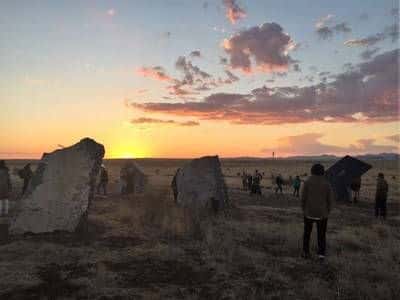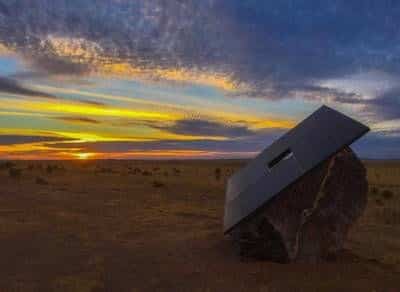Two of the best-known things about Marfa, Texas are the mysterious lights east of town and the Prada Marfa outdoor art installation. Now, those iconic sights are joined by a new and equally impressive landmark, an outdoor art sculpture that channels a very different kind of light.
Ballroom Marfa, the cultural arts nonprofit that commissioned Prada Marfa, just unveiled an ambitious new project in the desert just outside downtown. Stone circle by London-based artist Haroon Mirza is a large-scale outdoor sculpture with a solar-powered light and sound show that will be in the landscape for five years.
The Past Meets the Future
Haroon Mirza grew up in England, where Stonehenge and other ancient stone circles and megaliths are a familiar part of the landscape. However, his work is futuristic and multimedia-based. “My medium is electricity,” says Mirza, who takes this natural phenomenon and makes it audible and visual. Last year he was awarded an artist residency in Geneva through Arts at CERN. CERN is committed to creating dialogue between artists and particle physicists.
Mirza recalls how the massive cooling towers of the Large Hadron Collider. A monument to modern technology, rise dramatically above the landscape. He imagined those structures still standing thousands of years from now. Abandoned relics that could be as mysterious to future generations as Stonehenge is to us today. Impressive technological feats for their age, but whose purpose is lost to history.
In stone circle, modern technology and ancient materials combine to create a reflection on energy in all its forms. For example, the geological process that created the marble required millions of years of heat and pressure. Significant human and mechanical resources, not to mention actual fuel powering the trucks, went into transporting those stones from Mexico to Marfa. The solar and battery powered electricity that creates the sound and light performance each month is another facet to the project. Even the scheduling of that performance to align with the lunar calendar was intentional. A nod to the moon’s tidal effect (another form of energy).
It was modeled after Nine Ladies in Yorkshire, which also has nine boulders in a circle with a large “mother stone” that sits outside the circle. The modern artwork is unique in two key ways.
First, stone circle has solar panels installed on the mother stone, which charge batteries that power a monthly sound and light show. It is programmed to display a half hour after the sun sets on each full moon. Using solar PV panels “gives you an unmediated channel from the sun to electricity,” says Mirza.
Second, the massive black marble stones used in the sculpture were shaped and transported using modern tools and techniques. In some ways seem as mysterious as in ancient times. Neither Mirza nor the rest of the team had never worked with such large-scale materials. That turned the creative process into a community effort.
Mirza and the Ballroom Marfa team acknowledge that it took a village to create stone circle. Matt Grant coordinated all of the project details from Marfa. Stephen “Chick” Rabourn helped design the stones working with the artisans in Mexico and got them moved to Texas. Finally, Freedom Solar designed and installed the solar and battery system from Austin. In the end the entire community got energized around the possibilities of solar power in their community.
“You can’t make a megalith overnight.”
So says Laura Copelin, the Executive Director and Curator at Ballroom Marfa. It has taken half a decade and required an extraordinary degree of problem solving to pull it off. Obstacles ranged from the creative (planning and scoping the sculpture as a team) to the practical (fundraising, the logistics of finding experts for something that had never been done before). Copelin admits that if they knew then what they know now, it might never have happened – yet of course everyone is happy that it did.
It all started when Ballroom Marfa connected with Mirza five years ago. They began discussing ideas for a future project on which they could collaborate. A Ballroom board member asked Mirza for the craziest, most ambitious idea he could dream up. He said a stone circle in the desert. Even without any real idea what that would take, Ballroom said “let’s do it.”
First, they had to find a site. It’s actually more difficult than it sounds in a place known for its wide-open spaces. Marfa is essentially boxed in on all sides by private property. There wasn’t a plot of public land large enough to house the sculpture. Eventually, a deal was reached with a local landowner to lease a portion of their property that is accessible from the road for five years.
The next challenge arose from the stones themselves. Their size and weight made them complicated for the stonecutters at the quarry in Mexico to carve and made them even more difficult to transport across the border and to the final site. It was a surprisingly complex engineering and logistical challenge for the artisans, drivers, riggers, and others. The mother stone, for example, is 22,000 pounds – about 6 times the weight of your car – and not shaped for easy transportation. As Rabourn said, “everyone involved was thrown off a bit by the scale and aesthetics of this project.”
Then, they had to find a solar company who could install an off-grid system where the solar array is attached to a boulder and the batteries are buried underground. Copelin had been cold-calling solar companies: “I’ve got this project. It’s a megalith in the desert.” She had gotten nowhere, when by happy accident Alex Seyer from Freedom Solar called her. He’d been interested in expanding Freedom’s operations out west. He noticed on Google Earth that Ballroom appeared to be the only building in town with solar. Even before Seyer and lead designer Josh Meade took on the task of figuring out how to build it, the company’s owners were understandably skeptical about giving away solar for artwork in the desert. “The reaction to this was that it’s nuts,” says Seyer. But he passionately pursued approval of the project over a period of months. In the end, Freedom Solar agreed to donate half the cost of the system and established an innovative way for Ballroom to earn back the rest of the cost through a community referral program.
Launching a Solar Revolution in West Texas
Because of the referral program that Freedom Solar set up with Ballroom Marfa, which kicked off with a “solar social” event in August of 2017, residential solar projects caught like wildfire. In fact, the total number of projects completed in the AEP utility last year almost doubled that of 2016, from 23 to 44.
Out of that first event, a group calling themselves the “Marfa Solar System” made it their mission to expand solar in far west Texas. Buck Johnston, who within the past year installed solar on her home and business, was just elected to one of three Marfa City Council seats. Part of her platform is to set a goal for Marfa to be powered by 100% renewable energy, which would make it only the third city in the state of Texas to do so, after Georgetown and Denton. She wants to begin with the Marfa Independent School District, seeing solar as both an economic and educational opportunity.
It is exciting to see the town of Marfa embracing solar power and getting directly involved in bringing the technology to its residents. The future looks bright for Far West Texas!
What’s Next
Be sure to make the trip to Marfa to see stone circle. The ideal time would be during a full moon so that you can see the nighttime program. Good news is you have five years to plan! The exhibit is accessible during Ballroom Marfa’s opening hours, Wednesday through Saturday, 10am-6pm, and Sunday, 10am-3pm; as well as during the evening of each full moon.
Just stop by Ballroom Marfa at 108 E. San Antonio St. / Highway 90 West to ask for details. Don’t forget to check out their current exhibition while you’re there. Through October, you can see Hyperobjects, an amazing group exhibition organized by Copelin and Timothy Morton.
If you’d like to do more to support this project, go solar! The program that provides financial support to Ballroom Marfa for this project is accessible to anyone in the state. Just contact Freedom Solar at 877-969-1946 or online and mention Ballroom Marfa.

